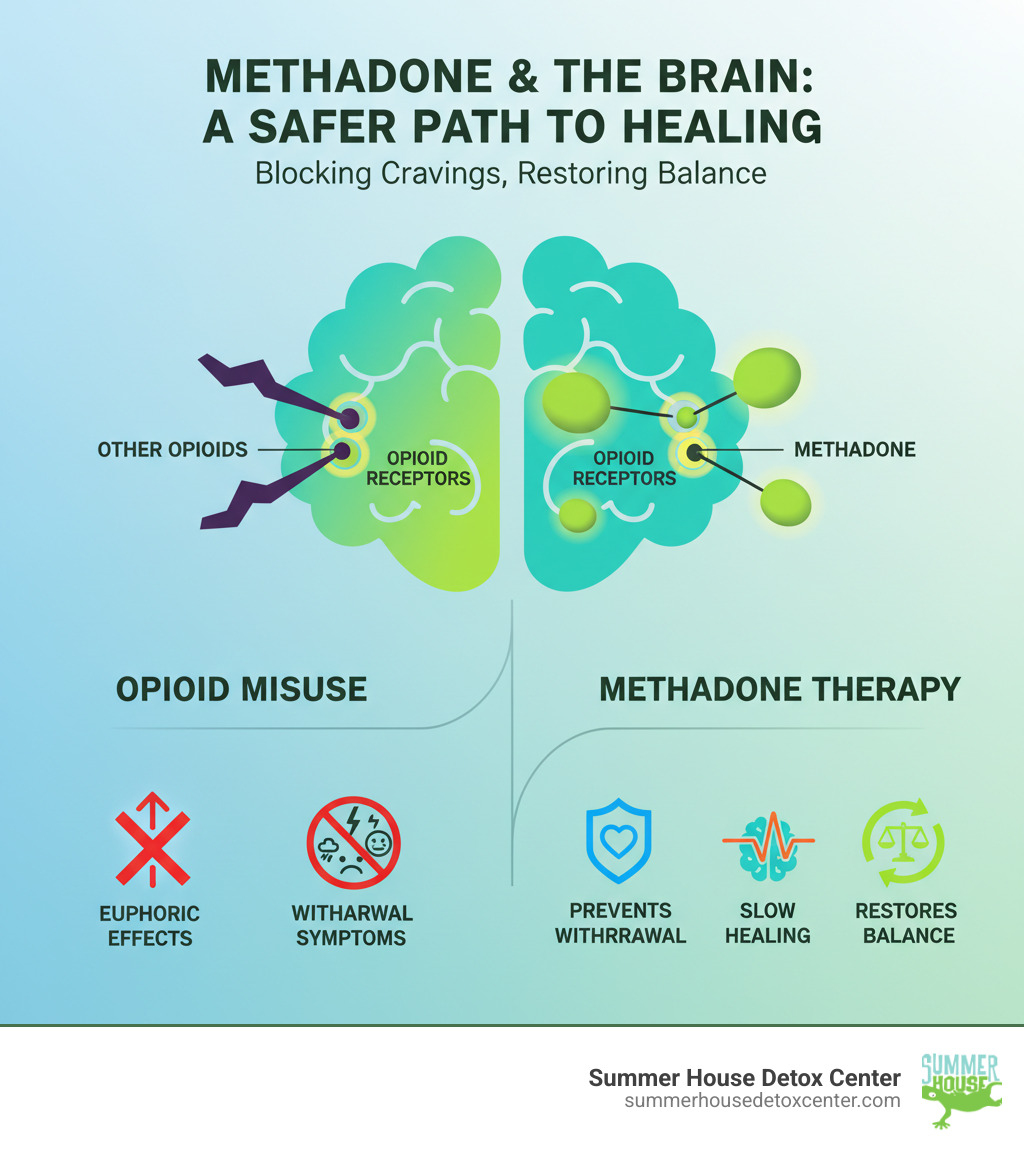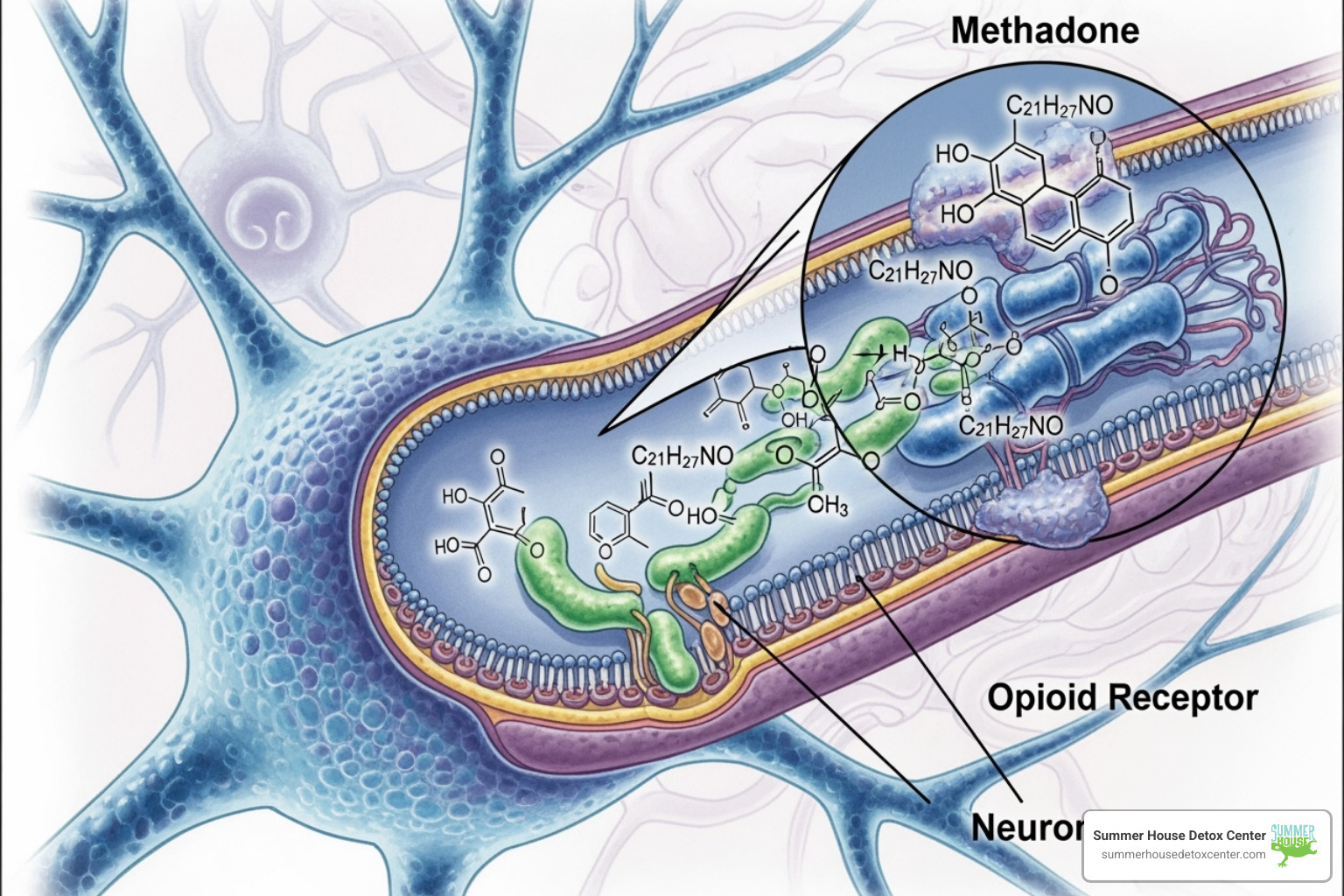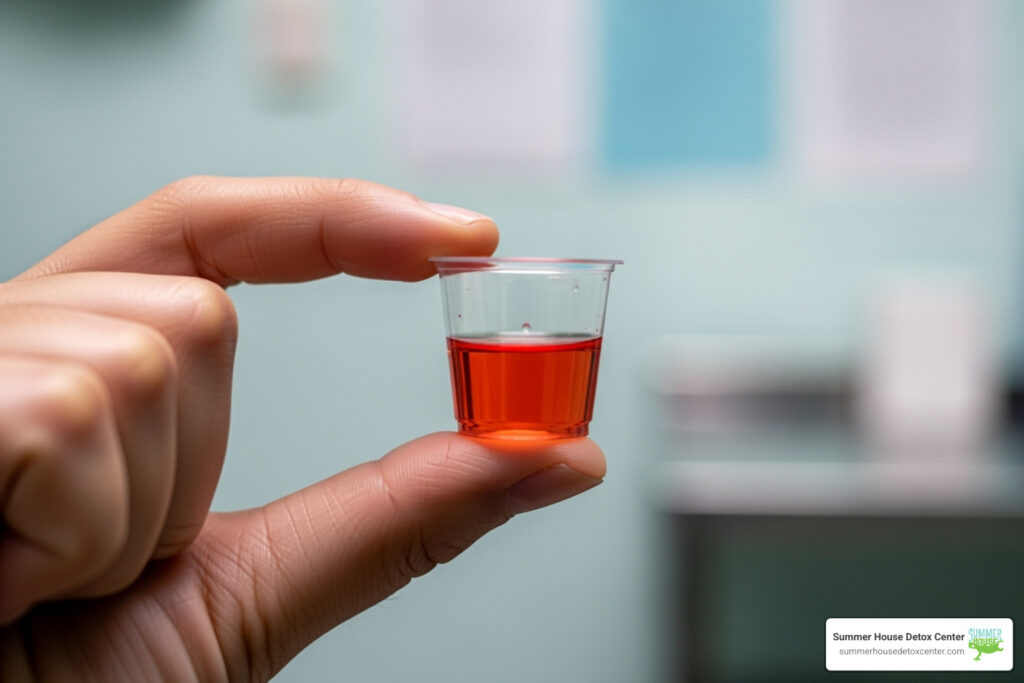Why Methadone Is Essential for Safe Opioid Detox
Why is methadone used to detox from opioids? It’s one of the most common questions we hear at Summer House Detox Center in Miami. The answer lies in methadone’s unique ability to prevent severe withdrawal symptoms while allowing your body to heal safely.
Key reasons methadone is used for detox:
- Prevents dangerous withdrawal symptoms like seizures and severe dehydration
- Reduces intense cravings that lead to relapse
- Allows gradual tapering instead of stopping “cold turkey”
- Enables focus on recovery rather than just surviving withdrawal
- Medically supervised safety with 24/7 monitoring
For many people struggling with opioid addiction in South Florida, the fear of withdrawal keeps them trapped in the cycle of use. One person shared: “I was terrified of the pain and sickness. Methadone helped me get through those first weeks without feeling like I was dying.”
Methadone works because it’s a long-acting opioid that satisfies your brain’s receptors without the dangerous highs and crashes of street drugs. This stability gives you the mental and physical space needed to engage in counseling and build recovery skills.
The science is clear: Studies show that methadone-assisted detox significantly reduces illicit opioid use, keeps people in treatment longer, and dramatically lowers overdose death rates compared to going without medication support.
At Summer House Detox Center, we’ve seen how proper medical supervision during methadone detox can transform what feels impossible into a manageable first step toward freedom.

Why is methadone used to detox terms simplified:
What is Methadone and How Does It Work?
Why is methadone used to detox from opioids? The answer starts with understanding what methadone actually is and how it works in your brain.
Methadone is a synthetic opioid agonist – essentially a medication that speaks the same language as your brain’s opioid receptors. These are the same receptors that respond to heroin, fentanyl, and prescription painkillers. But here’s the key difference: while street opioids create intense highs followed by devastating crashes, methadone works much more gently and steadily.
Think of your brain like a parking garage with specific spots for opioids. When you use heroin or other street drugs, they rush into these spots, create chaos, then leave quickly – making you desperately want more. Methadone takes a completely different approach. It slowly fills those same parking spots and stays there for hours, keeping everything calm and stable.
This long-acting effect is what makes methadone so effective for detox. Instead of the roller coaster of euphoria and withdrawal that keeps people trapped in addiction, methadone provides steady, consistent relief from cravings and withdrawal symptoms without the dangerous highs.
The National Institute on Drug Abuse explains that methadone works by “attaching to opioid receptors in the brain” – the same areas that control pain, pleasure, and reward. When methadone binds to these receptors, it prevents withdrawal symptoms, reduces cravings, and blocks the euphoric effects of other opioids if someone tries to use them.
This makes methadone a cornerstone of Medication-Assisted Treatment (MAT) for people struggling with Opioid Use Disorder here in Miami and throughout Florida.

The Science Behind Why Methadone Is Used to Detox
The science behind why methadone is used to detox comes down to some fascinating brain chemistry that makes all the difference in your recovery journey.
Methadone is what scientists call a “full agonist.” This means it completely activates your brain’s opioid receptors, but in a slow, controlled way. Compare this to partial agonists that only partially activate these receptors – methadone’s full activation is especially helpful for people with severe opioid dependence who need complete relief from withdrawal symptoms.
Here’s what makes methadone special: its incredibly long half-life of 24 to 36 hours. In simple terms, this means one dose can keep working in your body for an entire day or longer. This extended action is crucial because it prevents the crash-and-craving cycle that makes detox so difficult.
When you stop using opioids suddenly, your brain goes into chaos. Neurotransmitters like dopamine – which control mood, motivation, and pleasure – become severely imbalanced. This creates the intense physical and emotional pain of withdrawal that drives people back to using.
Methadone stabilizes your central nervous system during this vulnerable time. It gives your brain the time it needs to slowly readjust and heal, rather than forcing it through the trauma of sudden withdrawal. This stabilization process is why medical professionals can safely guide you through detox with much less suffering.
At Summer House Detox Center in Miami, we use this science-based approach to make your detox as comfortable and safe as possible. The gradual, controlled nature of methadone allows our medical team to carefully manage your withdrawal, giving you the best chance at successful recovery.
Why Is Methadone Used to Detox from Opioids?
Why is methadone used to detox from opioids? The answer comes down to one crucial factor: it transforms an otherwise unbearable process into something manageable and safe. For someone who’s been using heroin, fentanyl, or prescription painkillers regularly, stopping suddenly isn’t just painful—it’s often impossible without medical help.
When you try to quit opioids “cold turkey,” your body goes into crisis mode. The severe withdrawal symptoms—intense muscle aches, nausea, anxiety, and overwhelming cravings—become so consuming that most people can’t think about anything else. Recovery work? Forget about it. You’re just trying to survive each hour.
Methadone changes this entire equation. By providing medical stability, it allows your body to function normally while you focus on the real work of recovery. Instead of spending your days fighting withdrawal symptoms, you can participate in counseling sessions, learn coping skills, and address the underlying issues that led to addiction in the first place.
Here in Miami, we see this change daily at Summer House Detox Center. One client told us, “For the first time in years, I could actually listen during therapy instead of just counting minutes until I could use again.”
The statistics speak volumes about methadone’s effectiveness. Research consistently shows that people using methadone for opioid detox have significantly reduced illicit drug use, stay in treatment longer, and face dramatically lower overdose risks compared to those trying to quit without medication support.
This isn’t just about managing symptoms—it’s about creating space for genuine healing and giving people their lives back.
Key Benefits: Why Is Methadone Used to Detox Over Other Options?
The question of why is methadone used to detox becomes even clearer when you compare it to other approaches. Going “cold turkey” might sound straightforward, but for someone with severe opioid dependence, it’s often a recipe for failure and unnecessary suffering.
Avoiding the dangers of abrupt cessation is perhaps methadone’s most important benefit. While opioid withdrawal isn’t typically life-threatening on its own, the severe dehydration from constant vomiting and diarrhea can create serious medical complications. More critically, the intense discomfort drives most people back to drug use within days or even hours.
Managing severe withdrawal effectively is where methadone truly shines. For people who’ve been using high doses of potent opioids like fentanyl—which we see frequently in South Florida—methadone’s full agonist properties can completely eliminate withdrawal symptoms. This is especially important for individuals who’ve tried to quit before and found other approaches insufficient.
The reduced overdose risk cannot be overstated. When someone is stabilized on methadone, they’re not seeking out dangerous street drugs of unknown purity and strength. This alone saves countless lives in communities like ours where fentanyl contamination makes every illicit purchase potentially fatal.
Improved treatment retention happens naturally when people aren’t fighting constant cravings and withdrawal symptoms. They can focus on therapy, build relationships with counselors, and develop the tools they need for long-term recovery. At Summer House Detox Center, we’ve seen how this stability allows people to engage fully in their treatment program.
Perhaps most importantly, methadone allows people to function normally in their daily lives. They can maintain jobs, care for their families, and participate in their communities—things that are impossible when you’re either high or in withdrawal.
Methadone’s Role in Harm Reduction
Beyond individual treatment, methadone serves a crucial role in protecting public health throughout Florida and beyond. The reduced HIV transmission that occurs when people stop injecting drugs has transformed entire communities. When someone is stable on methadone, they’re no longer sharing needles or engaging in the high-risk behaviors that spread bloodborne diseases.
Decreased criminal activity is another significant benefit that affects everyone. Opioid addiction often drives people to theft, drug dealing, or other crimes to fund their habit. Methadone maintenance treatment studies show dramatic reductions in criminal behavior, making communities safer for everyone.
The public health benefits extend to families as well. Children of parents in methadone treatment are more likely to have stable homes, and improved outcomes for pregnant individuals mean healthier babies and stronger families.
This comprehensive approach to harm reduction is why methadone isn’t just a medical treatment—it’s a community health strategy that benefits all of us. At Summer House Detox Center, we’re proud to be part of this evidence-based approach to healing both individuals and our Miami community.
The Methadone Detox Process: Timeline and Symptoms
When you’re wondering why is methadone used to detox, understanding the actual process can help ease your concerns. At Summer House Detox Center in Miami, we’ve guided hundreds of people through this journey, and we want you to know exactly what to expect.
The truth is, methadone detox isn’t a one-size-fits-all process. Your timeline depends on several factors: how much methadone you’ve been taking, how long you’ve been on it, your overall health, and whether you have any other medical conditions. That’s why we create a medically supervised detox plan that’s custom specifically to you.
Here in Florida, our detox regulations are strict for good reason – your safety comes first. We follow individualized treatment protocols that allow us to adjust your care as needed throughout the process.
The tapering schedule is the heart of safe methadone detox. Instead of stopping suddenly (which would be incredibly uncomfortable and potentially dangerous), we gradually reduce your dose over time. Think of it like slowly turning down the volume on a radio rather than hitting the off switch.

What to Expect During a Medically Supervised Taper
Here’s the reality: methadone withdrawal is different from other opioids because of its long-acting nature. While this makes it excellent for treatment, it also means withdrawal unfolds more slowly. Our medical team is with you 24/7 throughout this process, monitoring your comfort and adjusting your care as needed.
Early symptoms typically start 24-36 hours after your last full dose. Because methadone stays in your system longer than shorter-acting opioids, you might not feel anything at first. When symptoms do begin, they often feel like a mild flu: muscle aches, watery eyes, runny nose, and increased sweating. You might find yourself yawning more than usual, and anxiety and restlessness can start creeping in.
The most challenging period usually hits around days 7-10. This is when symptoms reach their peak intensity. You might experience severe muscle and joint pain, nausea, vomiting, and diarrhea. Your heart rate may increase, your blood pressure might rise, and you could notice your pupils are larger than normal. Insomnia becomes a real struggle during this time.
The psychological symptoms can be just as tough as the physical ones. Intense cravings, irritability, and severe anxiety are common. Some people experience depression or feel paranoid. One of our patients described it as “feeling like my emotions were turned up to volume 11.”
Lingering symptoms can persist for weeks 2-3 and sometimes beyond. The good news is that the worst is usually over by this point. You might still deal with persistent fatigue, sleep disturbances, and mood swings. Some people experience what we call Post-Acute Withdrawal Syndrome (PAWS), where psychological symptoms like anxiety and cravings can come and go for months.
This is exactly why we don’t just focus on getting you through detox – we prepare you for the road ahead with comprehensive therapy and solid aftercare planning. You can learn more about managing this entire process in our detailed guides: How to Get Off Methadone and Methadone Detox 101.
Understanding the Risks and Side Effects
Let’s be completely honest about methadone – while it’s a lifesaving medication, it’s not without risks. Understanding these helps us keep you safe throughout your detox.
First, it’s important to understand the difference between physical dependence and addiction. Physical dependence is your body’s normal response to having methadone in your system regularly. When you reduce or stop, your body needs time to readjust – that’s withdrawal. This is completely normal and expected.
Addiction, on the other hand, involves compulsive drug-seeking behavior despite negative consequences. When used properly under medical supervision, methadone helps manage physical dependence while you work on the behavioral aspects of recovery. However, misusing methadone can lead to addiction to the medication itself.
Overdose risk is real and serious. Methadone’s long half-life means it builds up in your system over time. Taking too much, or combining it with other substances, can be deadly. This is especially dangerous in the first two weeks of treatment, where deaths have occurred at doses as low as 40-60mg per day. This is exactly why our medical supervision is so intensive during this period.
Drug interactions can be particularly dangerous. Methadone doesn’t play well with many other medications, especially benzodiazepines like Xanax or Ativan. This combination dramatically increases your risk of respiratory depression and death. We have an entire article dedicated to The Dangers of Mixing Methadone and Benzodiazepines because this interaction is so serious.
Other medications that can interact include certain antidepressants and HIV medications. They can either increase methadone levels (raising overdose risk) or decrease them (potentially causing withdrawal symptoms). This is why we need to know about every single medication, supplement, or substance you’re taking – no judgment, just safety.
Common side effects you might experience include constipation (very common), nausea, vomiting, excessive sweating, drowsiness, and changes in your sex drive. These are typically manageable with proper medical support.
The bottom line? These risks are exactly why we never recommend trying to detox from methadone on your own. Our comprehensive approach, detailed in our guide on Side Effects and Long-Term Effects of Methadone, ensures you get through this process as safely and comfortably as possible.
Short-Term Detox vs. Long-Term Maintenance
When you’re exploring why is methadone used to detox, it’s helpful to understand that there are actually two different paths you might take. Think of it like choosing between a sprint and a marathon—both get you where you need to go, but they work very differently.
Short-term detox is designed to help you manage those tough withdrawal symptoms over a few weeks, with the goal of being completely off all opioids afterward. This approach often works well for people who haven’t been using opioids for very long or those who really want to be medication-free as quickly as possible. The process typically involves acute withdrawal management over five to seven days in a residential setting like ours, though outpatient programs might extend this to 30 days or longer.
Long-term maintenance, or what we call MMT (Methadone Maintenance Treatment), takes a completely different approach. Instead of rushing to get off methadone, you might take it daily for months or even years. This isn’t about being “stuck” on medication—it’s about giving yourself stability for chronic relapse patterns and severe addiction.
The research is pretty clear on this: people who stay in MMT after leaving treatment facilities are much less likely to return to dangerous drug use compared to those who try to go completely medication-free right away. SAMHSA guidelines actually recommend that methadone treatment last at least 12 months, and some people benefit from much longer.
Both approaches happen through certified Opioid Treatment Programs (OTPs) here in Florida, which follow strict federal guidelines to keep you safe. The choice between short-term and long-term really depends on your unique situation, and that’s something our medical team helps you figure out together.
Is Methadone Right for You?
This is probably the most important question you’ll ask during your recovery journey, and honestly, it’s one we help people work through every day at Summer House Detox Center.
Consulting medical professionals is absolutely essential—and we mean really digging into your story, not just a quick conversation. Our Miami team will want to understand your medical history, how long you’ve been using opioids, what types you’ve been using, and what your overall health looks like right now.
Assessing addiction severity plays a huge role in this decision. If you’ve been using high doses of potent opioids like fentanyl, or if you’ve been struggling with addiction for years, methadone might be exactly what you need to finally break free from that cycle.
Your history of relapse tells us a lot too. If you’ve tried to quit before and found yourself back to using within days or weeks, that’s not a personal failure—it’s information that helps us create a better plan. Sometimes your brain needs that extra stability that methadone provides to really focus on healing.
Lifestyle factors matter more than you might think. Do you have a stable place to live? Supportive family or friends? A job you need to keep? MMT requires daily clinic visits at first, so we need to make sure that works with your life in South Florida.
Most importantly, what are your personal goals for recovery? Some people dream of being completely medication-free, while others just want to stop the chaos and be able to function normally again. Both goals are completely valid, and both can guide us toward the right treatment approach.
At Summer House, we believe there’s no “right” or “wrong” choice—only what’s right for you at this moment in your life. If you’re considering inpatient care, our facility offers the kind of supportive, medically supervised environment where you can really focus on healing. You can learn more about our personalized programs at Inpatient Methadone Detox Near Me.
Finding a Safe Path to Recovery in Miami
Recovery from opioid dependence is one of life’s most challenging journeys, but you don’t have to walk it alone. At Summer House Detox Center in Miami, we’ve dedicated ourselves to creating a sanctuary where healing begins—a place where why is methadone used to detox becomes clear through compassionate, evidence-based care.
Our approach goes far beyond simply managing medications. We believe true recovery happens when you address the whole person, not just the addiction. That’s why our comprehensive care weaves together medically supervised detox with behavioral therapy, individual counseling, and peer support from people who truly understand your struggle.
Many of our staff members have walked in your shoes—they’re in recovery themselves. This isn’t just a job for them; it’s a calling. They bring an irreplaceable combination of professional expertise and personal understanding that can make all the difference when you’re feeling lost or hopeless.
What sets us apart in South Florida is our commitment to personalized treatment that honors your dignity every step of the way. We know that asking why is methadone used to detox often comes from a place of fear about the unknown. Our medical team takes time to explain every aspect of your treatment, ensuring you feel informed and empowered throughout the process.
The journey doesn’t end when detox is complete. Before you leave our facility, we work closely with you to develop a robust aftercare plan custom to your life in Miami and beyond. This might include connections to outpatient therapy, local support groups, or community resources throughout South Florida. We’ve learned that detox is just the beginning—lasting recovery requires ongoing support and community.
Our medically supervised environment means you can focus entirely on healing while we handle the medical complexities. You’ll have access to 24/7 care from professionals who understand both the science of addiction and the human heart behind it.
If you or someone you love is struggling with opioid dependence, we’re here to help you find your way forward. Recovery is possible, and it starts with a single brave step. Learn more about how we can support your journey through our specialized Detox Services: Methadone Detox program.
Your new beginning is waiting.

